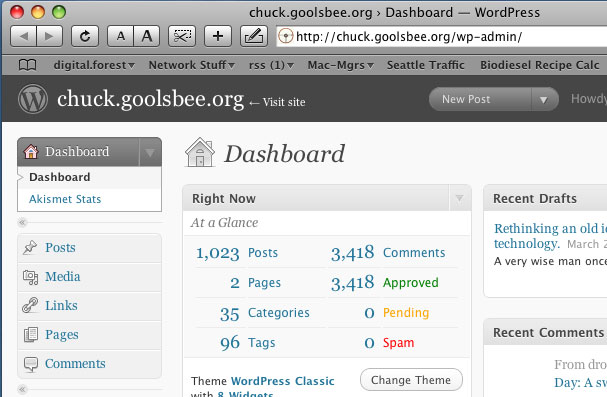
Back in September of 2005, right after I came back from the Colorado Grand, I switched from building all my webpages by hand to running WordPress. Prior to that I had written all the HTML code one character at a time in Rich Siegel’s wonderful BBEdit and dropped them on my server (a shockingly underpowered machine!) located at digital.forest’s datacenter. It was honestly a huge pain in the ass, and I rarely updated the site because of this. Updates usually only happened in the midst of some important event, such as driving from NYC to LA with a bunch of other old cars, or a wonderful road trip with Nicholas as we brought the Jaguar home for the first time. I’d been using the “MoveableType” content management system (aka “blogging platform”) at work for our support website, so already had an idea of what I wanted. WP looked to be the one to use, so I set it up on one of the web severs at the office and started putting in content. Along the way I’ve picked up a nice group of folks to chat with… several hundred of you actually. Some knew me before I started, quite a few have found this place since. A lot of you have hung around and really participated. Thanks!
I noted today that I’ve reached something of a milestone with this post: the 1,024th one since I started using WP to publish my photos, thoughts, confessions, news, and occasional maniacal rants. One thousand and twenty four. That’s a magic number for us geeks at it is the nearest we get to counting to one thousand, though it only takes us twelve numbers to get there. I figured I’d celebrate the milestone by sharing a few thoughts I’ve had about what I do here. Just as I said from the outset, I’m not looking to be a well-known pundit, or a vaunted member of the “blogosphere” … I just want to develop and present good stuff that rattles around in my head and eyes. In random order, here are some thoughts:
- Re-running old rally stories. The idea here is to repost some of my old (pre-blog, so 1998-2005) vintage rally stories, but this time with the ability to flesh out the tale a bit more. Often these were written in a summary style, late at night after a hard day’s driving, followed by dinner (with drinks!), lots of photo editing and uploading from dodgy hotel Internet connections, and written while my rally partner was snoring in the other bed. I’d re-write them and post them in a daily order.
- Interviews with other “car guys.” I’d love to develop a series along this line of thought: Talk to people who self-identify as “car guys” (no matter their gender) and find the common threads as well as the differences. Get their stories, histories, etc. The origins of their love for the automobile, the cars that got away, etc. I already know so many people I could talk to… literally around the world.
- Some more of the same. The tried and true: Rally & Road Trip stories in Real Time. Car Photo of the Day. Engine pR0n.
- Some Whimsy in the Mix A bit of story telling. A sprinkle of time lapse photography (I think I can get uber-HD time lapse stuff from my new DSLR!) More antique computer stuff if I can find the time.
- A new WP theme.That is, a change in the layout of the site. The content will remain, but the look will change. I always meant to move off the default “WP Classic” theme, as it is… dull. I never got around to it. I actually have another site where I’ve played with WP themes (don’t bother looking for that site… it is very anonymous and has nothing to do with me. It is just a place where I practice writing for writing’s sake) I think I’ve got a look worked out and if I can find the time I’ll implement it here. If you are some sort of Luddite and actually LIKE the way this site looks currently, let me know. 😉
- Some behind the scenes stuff. This is mostly server-related. Most of my photos are still hosted and served from my shockingly underpowered machine (seriously, it is a 266MHz G3!) while the WP site runs from a d.f FreeBSD shared hosting box, and the database is running on yet another d.f shared hosting server. I plan to collapse all those back down to a single machine… this time only mildly underpowered. Having the db and the http on the same box will let me do a few whizzy back-end things. No change for you, except maybe it will be a tad faster.
Feel free to comment and let me know what you think.


